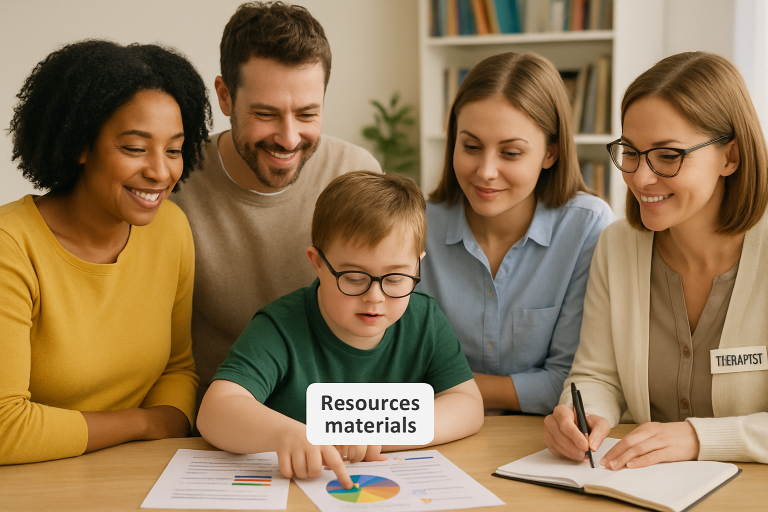Key Takeaways:
- Accessing comprehensive toolkits can empower families and educators to support individuals with Down syndrome effectively.
- Utilizing evidence-based strategies enhances learning and development outcomes.
- Collaborative efforts between families and educators foster inclusive environments.
Introduction
Navigating the journey of supporting individuals with Down syndrome calls for resources that inform, empower, and unify families and educational teams. Whether you are a parent, teacher, or community member, leveraging quality Down syndrome resources can significantly impact how you approach daily experiences and long-term planning for individuals with Down syndrome. Understanding the latest toolkits and best practices creates a supportive and adaptive environment, laying the groundwork for participation, learning, and belonging.
Families and educators play unique roles, but true success emerges when they work together, sharing perspectives, strategies, and goals. By committing to continual learning and open collaboration, they can collectively open doors to opportunities that foster greater independence and fulfillment for those with Down syndrome.
Access to well-structured toolkits enhances individuals' lives and provides much-needed clarity and assurance for those supporting them. Reliable resources address various aspects of daily living, education, communication development, and social integration, enabling smoother navigation of anticipated and unexpected challenges.
The digital age has dramatically expanded the availability and quality of practical materials, making it easier than ever to discover evidence-based plans, connect with supportive communities, and find step-by-step guidance. This interconnected support is essential in building confident advocacy and adaptive, inclusive learning environments.

Comprehensive Toolkits for Educators
Educators have a pivotal influence on students with Down syndrome's academic and social progress. Specialized toolkits, such as the Education Toolkit by Down Syndrome Australia, offer valuable strategies on adapting curriculum, modifying classroom activities, and embracing inclusive practices. These resources are essential in helping teachers meet the individual needs of learners while promoting overall classroom cohesion.
Furthermore, high-quality research from esteemed organizations like the Centers for Disease Control and Prevention (CDC) offers insights that help educators stay current on developmental milestones and health considerations, further supporting personalized and effective teaching methods.
Family-Centric Resources
Families are at the heart of advocacy and day-to-day support. Resources such as the Family Care Toolkit serve as comprehensive planning guides, addressing a wide range of topics from establishing routines to managing medical or behavioral emergencies. These materials often include checklists, sample plans, and real-life stories, providing practical tools and emotional reassurance.
Family-centric resources also include support networks where caregivers can share advice and experiences, forming vital links of community and encouragement. Platforms managed by national organizations and local Down syndrome associations further ensure families are never alone in their journey.
Speech and Language Development
Effective communication is key to social and academic engagement for individuals with Down syndrome. Speech and language challenges are common but can be supported through early intervention and targeted strategies. The Down Syndrome Toolkit for Pediatric Speech and Language Therapists is an extensively researched guide that provides milestones, activities, and customizable exercises for each developmental stage—from birth through adolescence.
Speech therapy resources can also guide families and schools using assistive communication devices, fostering broader participation and self-expression.
Inclusive Education Strategies
Inclusive classrooms benefit all students by championing diversity, empathy, and peer learning. Guides such as the Education Toolkit provide practical advice for implementing inclusive education. Teachers learn to adapt lesson plans, facilitate differentiated instruction, and create environments where everyone can thrive.
Building inclusive education doesn’t stop with teachers. Administrators, paraprofessionals, and therapists who invest in professional development and cross-team communication strengthen the support network for students with Down syndrome and their peers. For more on fostering productive educator partnerships, explore Edutopia’s insights on family-school collaboration.
Community Engagement and Support
Enabling participation in extracurricular, social, and community activities is vital for holistic development. The Community & Sporting Toolkit highlights the importance of adapting local sports programs, clubs, and recreational opportunities so individuals with Down syndrome can find meaningful inclusion outside the classroom.
Community engagement supports skills such as teamwork, independence, and self-confidence while providing platforms for advocacy and positive representation.
Collaborative Efforts for Success
Individual growth is best achieved through synergy between all support networks—families, educators, healthcare professionals, and community members. Resource-driven professional development, such as the DSAMn Educator Workshops, fosters ongoing education and equips adults to implement best practices consistently.
Regular communication, resource sharing, and unified goal-setting ensure that individuals with Down syndrome enjoy consistent encouragement and opportunities at every life stage.
Conclusion
With the right toolkit, families and educators are empowered to be advocates, guides, and cheerleaders—nurturing a sense of belonging and laying the path for achievement and happiness for individuals with Down syndrome. Comprehensive, accessible resources bridge gaps, inspire collaboration, and enrich educational and community experiences. By making informed use of these resources, we foster environments grounded in respect, opportunity, and hope.



No comments:
Post a Comment
I love reading and responding to comments but in order to get my reply you must ensure you are NOT a no-reply blogger. If you are, here are some quick steps to change that!
1. Go to the home page of your Blogger account.
2. Select the drop down beside your name on the top right corner and choose Blogger Profile.
3. Select Edit Profile at the top right.
4. Select the Show My Email Address box.
5. Hit Save Profile.